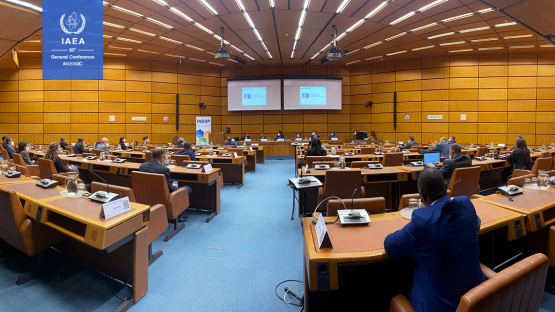The IAEA today marked 15 years of the IAEA Integrated Nuclear Security Support Plan (INSSP), which lays the groundwork for nuclear security support by the organization. At a side event on the margins of the 65th IAEA General Conference, speakers highlighted the impact of INSSPs and how this support mechanism has evolved to better adapt to countries’ needs.
“INSSPs are flexible and relevant for all States, from those States establishing their national nuclear security regime to those that want to strengthen their regime and identify areas for improvement,” said Lydie Evrard, IAEA Deputy Director General and Head of the Department of Nuclear Safety and Security. The INSSP is a mechanism for States and the IAEA to jointly review nuclear security regimes and to help States to identify areas that need to be strengthened. It also assists with coordinating the provision of nuclear security assistance from the IAEA and other assistance providers.
Since 2006, 112 countries have taken advantage of the INSSP mechanism. Upon request, the IAEA supports a State in the development of its country specific plan that outlines priorities and develops implementation strategies and a timeline to complete activities toward enhancing the country’s nuclear security regime. The plan also identifies roles and responsibilities and helps to facilitate internal coordination among national authorities for different aspects of the nuclear security regime.
Based on guidance in the IAEA Nuclear Security Series, the INSSP is structured around six nuclear security areas:
- legislative and regulatory framework,
- threat and risk assessment,
- physical protection regime,
- detection of criminal and unauthorized acts involving material out of regulatory control,
- response to criminal and unauthorized acts including material out of regulatory control, and
- sustaining a State’s nuclear security regime.
In the past 15 years, 92 countries have endorsed their country specific plan, including Paraguay, which was the first country to approve an INSSP in 2006. The INSSPs of the other 20 countries are in various stages of progress.
“Paraguay saw the importance of considering nuclear and radioactive security as part of our national security strategy,” said Juan Francisco Facetti, Resident Representative of Paraguay to the IAEA. “We requested an INSSP mission from the Agency, and based on it, we prepared our first national nuclear and radioactive security plan.” The plan established institutional capacities for the measurement and control of nuclear and radioactive material to address the potential risks of the illicit traffic of nuclear and radioactive material.
As part of the INSSP mechanism, the IAEA and countries jointly conduct INSSP reviews approximately every three years to assess progress and reassess national priorities. About 105 INSSP Review Missions have been conducted, to date. “The INSSP is developed and reviewed taking inputs from all national stakeholders with nuclear security responsibilities, to ensure that the Plan depicts an accurate picture of the situation in a concerned State and is being owned by the State,” Evrard said. “Its benefits in connection to building and strengthening nuclear security coordination is well appreciated, and several States have established national nuclear security coordination mechanisms on the basis of their INSSP.”








